Beyond Silver Bullets: How Innovators Share for Common Good
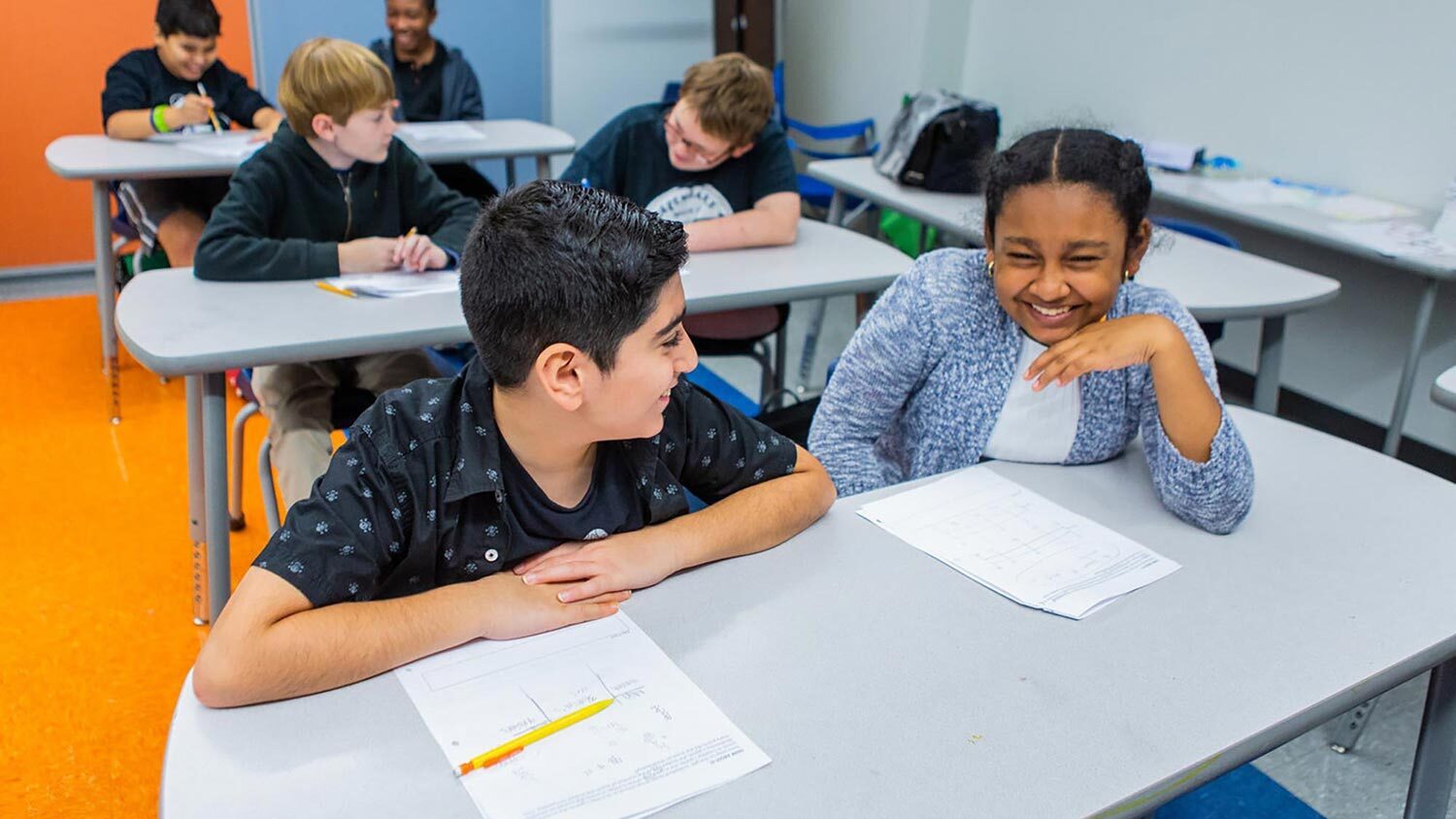
I vividly remember the first time I visited Valor Collegiate Academies. I observed a circle of fifth-grade boys. They started with a breathing practice, and I could sense the dynamic of the room change. The usual buzzing and fidgeting of a classroom became more still, more silent. Then, they went around the circle and shared a “strong emotion word” to describe how they were feeling. The teacher then checked back in with a few students to invite them to share more. I’d worked in middle schools for the previous eight years, and I’d never seen anything quite like this.

Later, a boy stood in the middle of the circle and shared that he was feeling frustrated at recess when other kids knocked over his blocks and wouldn’t let him play four square. When he finished, one of his classmates joined him in the middle, looked him in the eyes, acknowledged his feelings, and offered to support him at recess later that day. One by one, a handful of other classmates did the same. My eyes were tearing up. In most schools, I know how conflicts like these end: a shoving match, or maybe a bullied student who plays by himself at recess. But not at Valor. I thought to myself: I wish my former students had something like this. I wish I had this when I was little. I wish every kid in the country had this.
Just a few months later, we had our first meeting with Todd and Daren Dickson, the twin brothers who co-founded Valor. They came to us with an interesting challenge: tons of visitors were coming to observe, and then many of them would say something like, “Wow, that Circle practice is amazing. I want to do that at my own school. Can you help us?” Valor wanted to help, of course, but they weren’t exactly sure how, and they were very busy running their own, still new and growing schools.
This is a common challenge for many successful and innovative schools — and for the educators who visit them. In this piece, my colleague, Jenee Henry Wood, shares an all-too-familiar story of observing a great classroom and then trying to bring those practices back to her own school, only to see those practices get mixed results and ultimately be abandoned. Sharing innovative practices is no easy task. What we see when we observe them is only the foam on the top of the masterfully-crafted cappuccino. We can’t recreate these powerful student experiences in our own environments unless we know more about the ingredients and the process by which they’re put together.
Valor believed that they were onto something special, and they wanted to help other educators who were interested in adopting Circles. But they didn’t want to just have people come and see it and then try it on their own. This doesn’t work for most educational practices and it could be particularly challenging for Circle, given how different it is from many other instructional practices. Worse yet, done incorrectly, it could even set up an emotionally unsafe experience for young people.
So Valor decided to partner with Transcend to help them figure out how to share more effectively. For schools like Valor who are interested in sharing with other educators, we think there are three key questions:
- WHY share?:
- WHAT to share?
- HOW to share?

First, it’s important to get clear on your WHY — in other words, what’s your case for sharing? Some common motivations for sharing include: to expand impact, to respond to demand (from other schools, from funders, etc.), and to provide opportunities for increased brand recognition or revenue. For Valor, their why came from a deep belief that schools should be places for comprehensive human development that cultivate student growth beyond just core academics. They also believed that their Circle practice was one potentially powerful tool for this kind of social and emotional development. Valor wanted to support the visiting educators who were interested in bringing Circles back to their own communities, and they saw this as a way to expand their impact without having to just add more schools. Valor also saw sharing as a way to strengthen its own schools — e.g., the investment in stronger codification and training sessions would be internally valuable as well.
The next question is deceptively simple: WHAT to share? Most of the time, schools want to share whatever will lead to the best outcomes for students, but even this can be tricky to figure out. Learning environments can be peskily complicated entities. It’s not always clear which set of experiences are driving key results. In order to get clearer on this, school communities must get investigative about their models. We work with our school partners to document the design of their whole school model, often using a driver diagram or a blueprint. And then looking at this document, we can ask the question, “What’s in the box?” In other words, which of these things are we sharing, and which of them are we not? Then, potential model sharers must grapple with how prescriptive they want to be with what they decide to share.
For an innovative school, there are lots of different choices they could make about what to share — from smaller practices to more comprehensive models, from student materials to adult learning sessions, and from more prescriptive experiences to more customizable principles. One way to organize these different solutions is by their relative size and scope, and we think there’s a spectrum of options here1:
- Principles
- Point solutions
- Targeted Models
- Comprehensive models
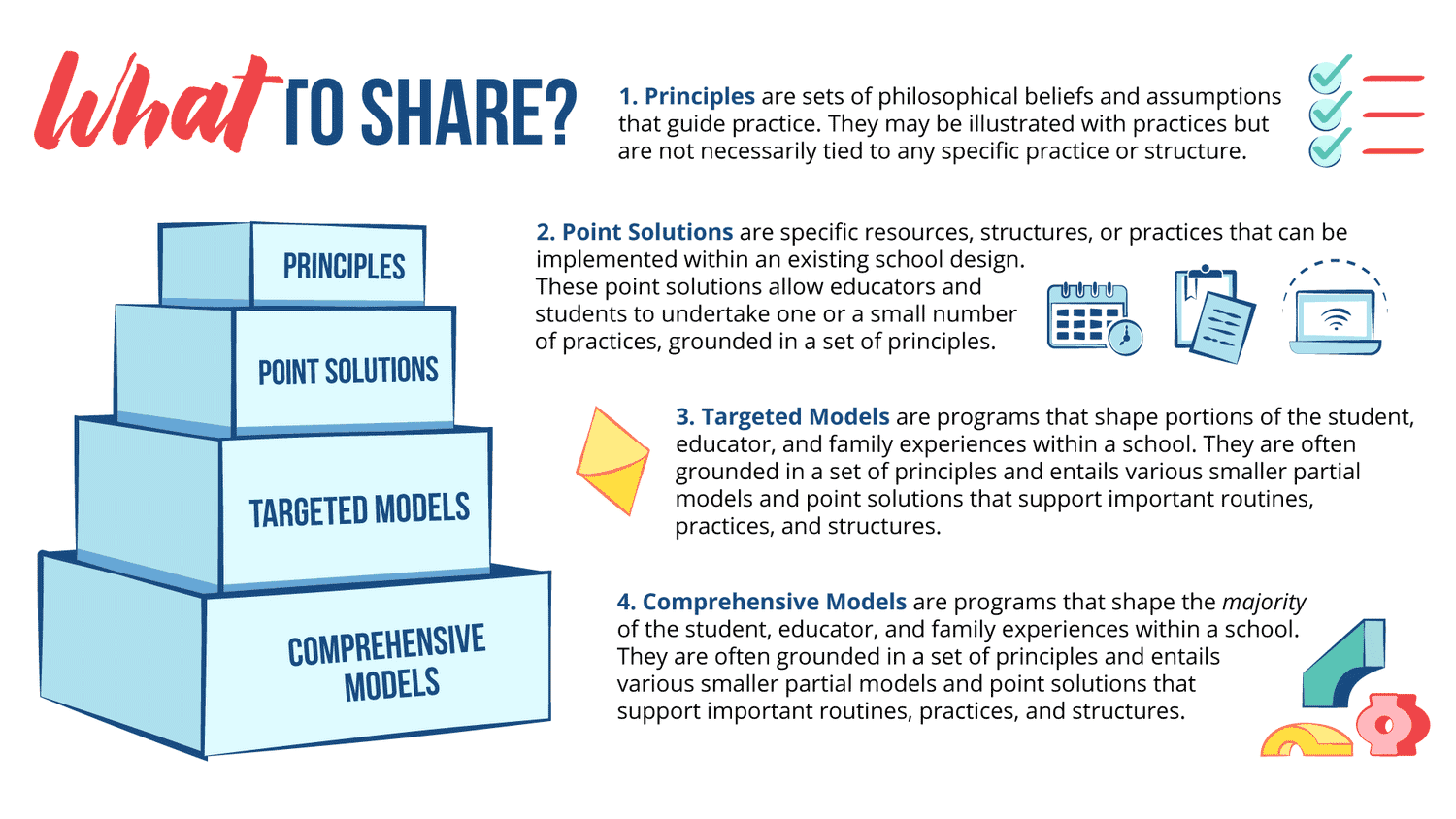
These options are not mutually exclusive. Schools show demand across the spectrum, and many innovators decide to share at multiple places on the spectrum as well. At Transcend, we think there is room and need for all of these in the education ecosystem; AND we think there’s particular promise in what we call “models.” We define models as programs that schools can adopt to shape the experiences of young people, families, and educators. We think that there’s often too much focus on sharing small solutions and on spreading whole-school designs (eg, via replication and growth within a network). We think models may be a “Goldilocks” solution: small enough to be adoptable by other communities, big enough to actually make a meaningful impact.
With Valor, we started by documenting their whole-school design. Even though we knew they weren’t interested in sharing all the parts of their school, we thought it was important to see all the different experiences in their design and how those experiences were connected with each other and their desired outcomes. We knew that the visiting educators wanted Circle. But through rigorous discussions grounded in their documented whole-school design, it became clear that we couldn’t just share the practice of Circle, because that wouldn’t lead to the same experience that the visitors observed. In order to share a Circle experience of similar quality and richness, Valor determined that schools would need to adopt:
- A student Circle practice
- An adult Circle practice
- The badge work curriculum that fuels a lot of the rich sharing in Circles
- Staff training on Circle foundations and facilitation
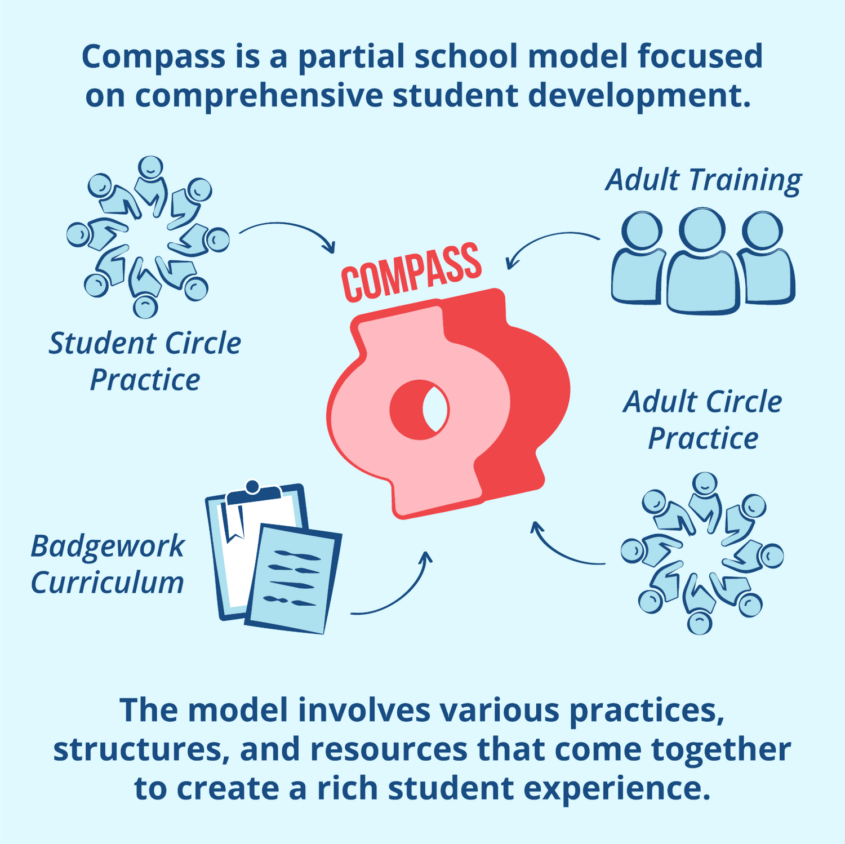
If schools were able to adopt these pieces, Valor hypothesized that they would be able to recreate the kind of student Circles seen in Valor’s classrooms. The list that Valor arrived at is a great example of a targeted model —Circle itself is a point solution and not a model, but this collection of practices, resources, and structures is a model (Valor calls it the Compass model). Notably, there are a many other related parts of Valor’s design that they chose not to include (e.g., other culture practices, behavior management approaches and systems, etc.), because Valor decided they weren’t essential to the Compass model and because Valor wanted to make sure that adopting schools weren’t taking on an unreasonable amount of change.
Once an innovative school decides on what to share, they must then figure out HOW to share it. Again, there are many different options in terms of format, intensity, length of time, etc. One particularly important dimension to consider is the intensity of the sharing support, and we think there’s a spectrum of options here including:
- Exposing
- Offering
- Providing
- Operating
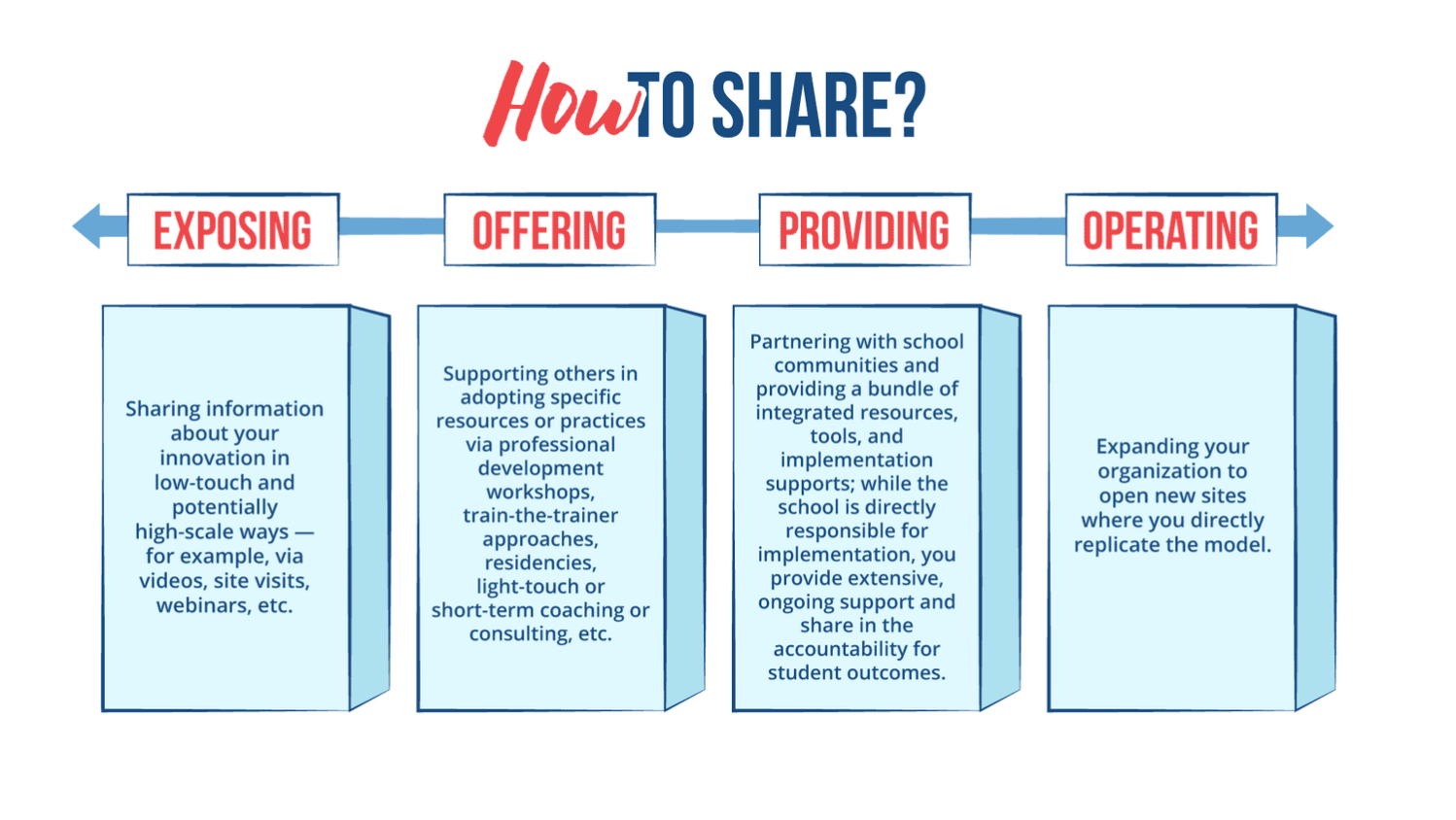
Just like for the WHAT, we think there is room and need for all these approaches to HOW; AND we think there’s often too much focus on the poles — e.g., just putting resources on a website (exposing) or just opening more schools (operating). We think there’s real promise in the middle (offering and providing), and we often find that many organizations develop sharing strategies that include multiple points on this spectrum.
For example, when thinking about how to share the Compass model (student and adult Circles, curriculum, and training), Valor knew they would need a pretty intensive support strategy. They ended up deciding on a multi-year, cohort-based approach called Compass Camp, which is an example of model providing. In addition, they have also continued to host Circle tours (an exposing strategy that also helps create a pipeline for Compass Camp) and added a Compass-in-Leadership program (an offering designed for school leaders).
Of course, these questions — WHY, WHAT, and HOW — are not separate questions. They are closely related, should be aligned with each other, and will likely need to be revisited over time. Another question innovators need to answer is when to share, which we won’t address here but hope to explore in a future piece. One interesting way to combine some of the key choices here is this WHAT/HOW grid, which shows different options related to the size/scope of the WHAT and the intensity of the HOW. See an example of Valor’s strategies on the grid below.
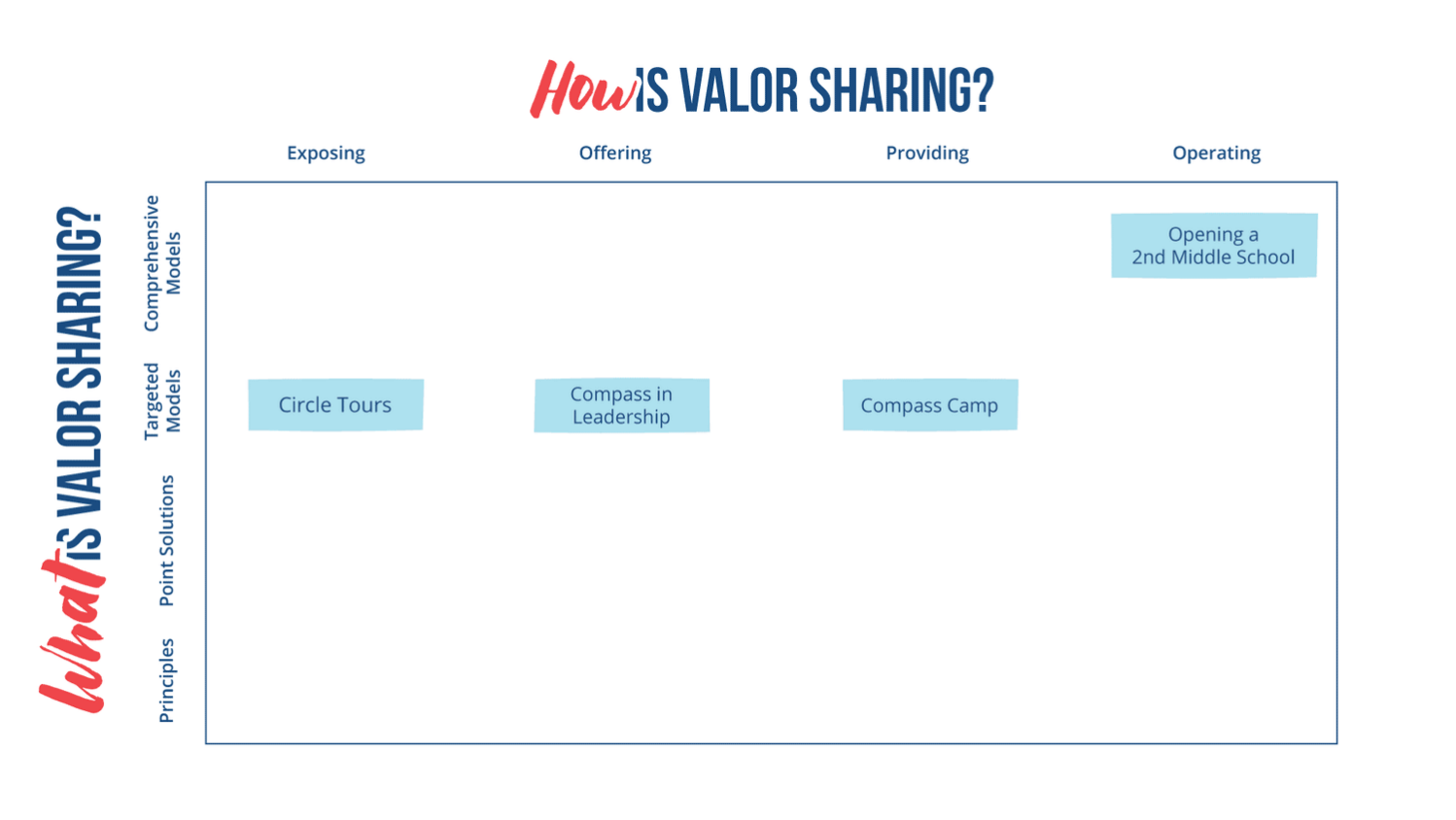
At Transcend, we work with many school communities across the country to ignite their innovative journey. These schools need access to more and better innovative models. At the same time, there are many innovations that are happening but lack the catalyst needed to reach others. In order to fuel the kind of transformation our schools need, we need a flourishing sector of model sharers and providers.
Click here to find a more detailed version of the choice cascade. If you’d like to learn more or explore these questions together, please reach out to me ryan@transcendeducation.org
1 This spectrum is roughly in order based on how much specification there is for the student experience. So principles and point solutions often specify less of the total student experience than something that we would call a “model.” Principles can be tricky, however, because they can exist at many levels — and some organizations share school-level guiding principles that, applied successfully, could end up shaping a large part of the student experience.
Transcend supports communities to create and spread extraordinary, equitable learning environments.

